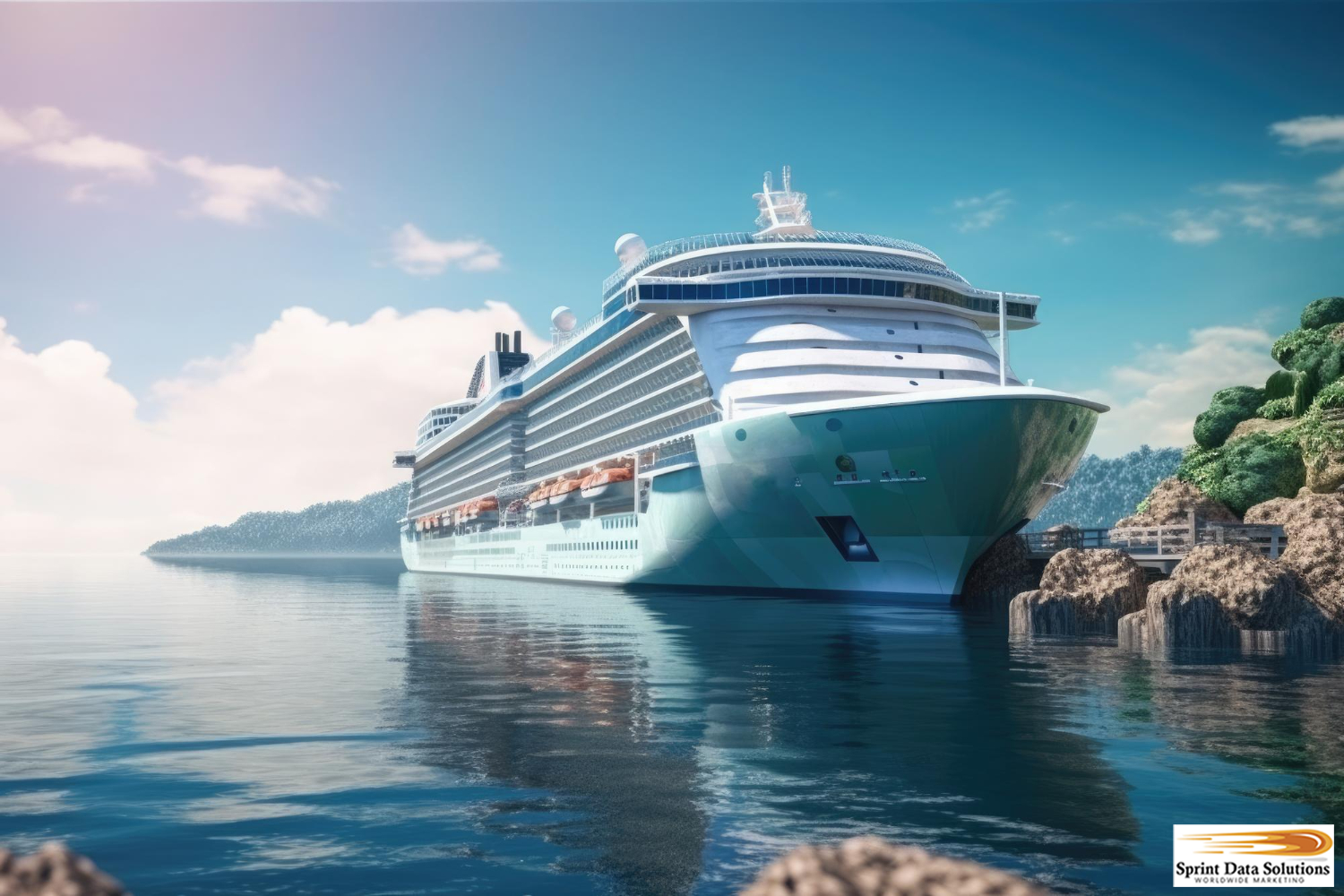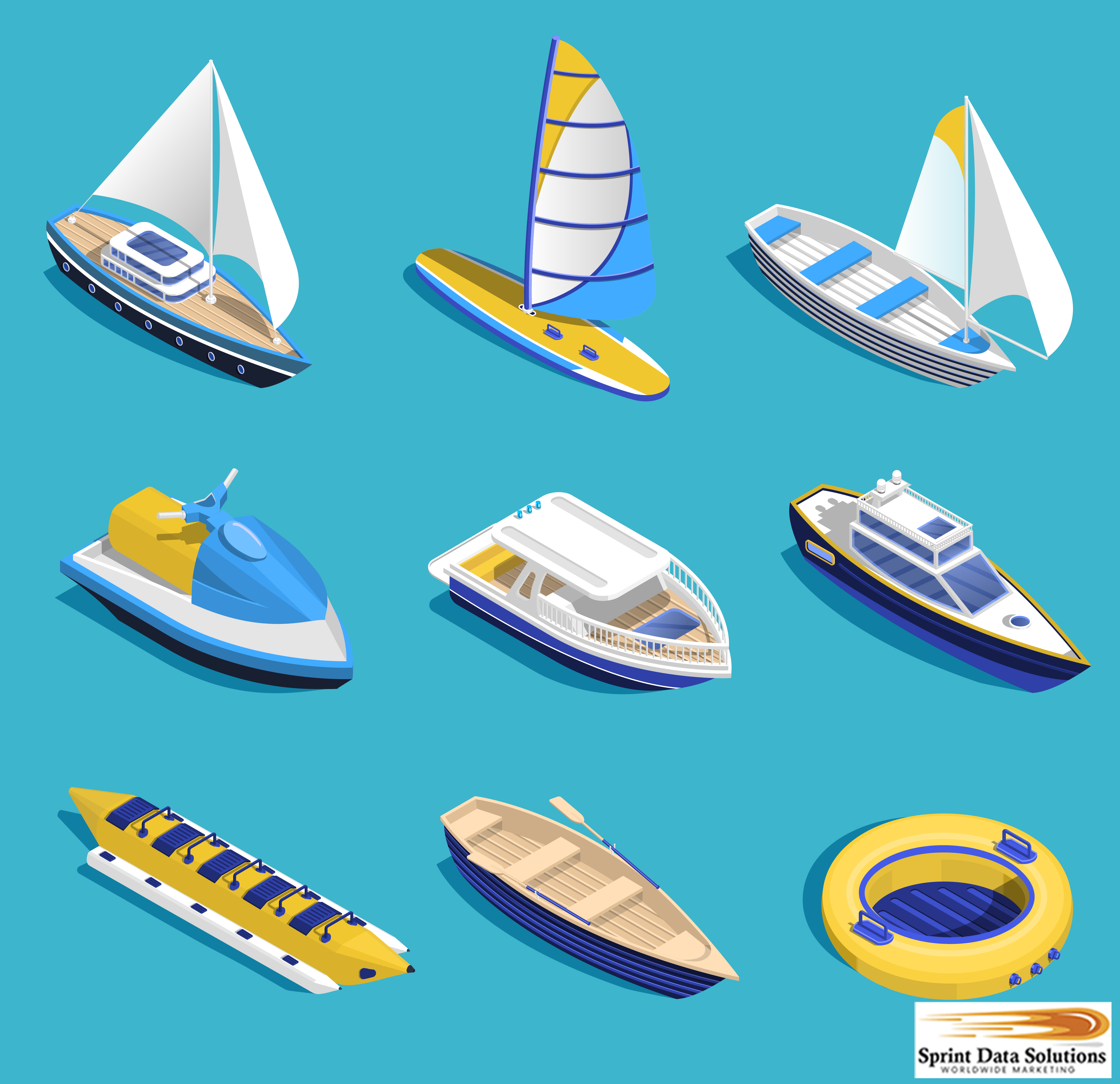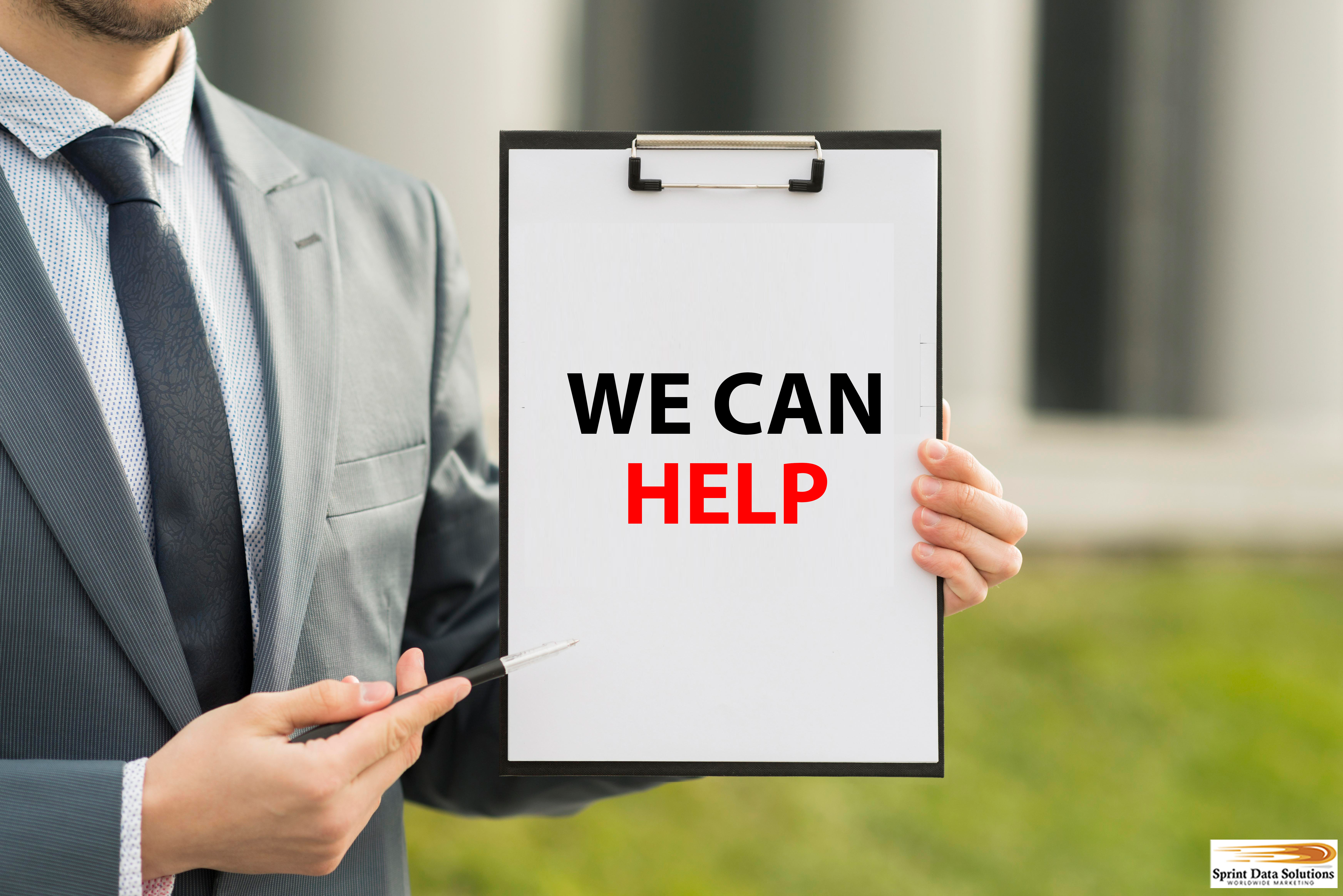Boat Owners Are An Excellent Target Market
Boat owners are a diverse and dynamic group of individuals who embody a unique lifestyle centered around freedom, adventure, and connection to nature. For many, boating isn’t just a hobby—it’s a way of life. Whether they are cruising the open waters, fishing in secluded spots, or enjoying scenic views with friends and family, boat owners are drawn to the water for both relaxation and recreation. Their boats are often an extension of their personalities and values, reflecting a love for exploration, outdoor activities, and a sense of independence.
Boat owners are typically highly skilled, self-sufficient individuals who value physical activity and engagement with the environment. Many boat owners are avid anglers, hunters, or outdoors enthusiasts, using their vessels as tools to support their passions. Others might use their boats as a retreat, a place to host social gatherings, or a venue for making lasting memories with loved ones. For those who are more adventurous, boating offers the opportunity for extended journeys along coastlines, upriver, or even across vast oceans, testing both their resilience and navigational skills.
In terms of lifestyle, boat owners tend to have a strong work-life balance, seeking out experiences that provide both relaxation and excitement. They are a community of like-minded individuals who enjoy sharing their passion with others, whether through online forums, social media, or in-person events. This makes boat owners a highly engaged and interactive group, which can be leveraged for marketing opportunities. They are frequently on the move, whether cruising to new locations, dockside, or exploring new waters, making traditional passive marketing methods less effective. Instead, boat owners respond best to targeted, personalized strategies that align with their adventurous spirit and lifestyle.
The boating community provides a wealth of opportunity for businesses to connect with an active, engaged consumer base. From outdoor gear and maintenance products to luxury accessories and services, boat owners have a diverse range of needs and interests that can be catered to through strategic marketing efforts. By accessing a well-targeted boat owner list, businesses can not only reach this group more effectively, but they can also tailor their messaging to resonate with boat owners’ passions, values, and lifestyle. This approach ensures that marketing efforts are not only seen but are more likely to convert into meaningful engagements and lasting customer relationships.

Boats Are Growing In Popularity Every Year
The recreational boat market in the U.S. was valued at approximately $16.26 billion in 2021 and is projected to grow significantly, reaching an estimated $26.18 billion by 2027, reflecting a compound annual growth rate (CAGR) of 8.26%. This growth can be attributed to several key factors, including the rapid advancements in marine technologies, which have led to more efficient, sustainable, and user-friendly vessels. The increasing popularity of outdoor recreational activities, particularly water sports such as boating, fishing, and water skiing, is driving demand for both leisure and sport vessels. Additionally, the ongoing boom in the tourism industry has further fueled the market, with many travelers seeking unique water-based experiences. Furthermore, the rising trend of boat-based small businesses—ranging from luxury yacht charters and floating restaurants to water taxis and sightseeing tours—has added a new dimension to the market, making boats a preferred choice for entrepreneurial ventures. The expanding market is also supported by innovations in electric propulsion systems, eco-friendly materials, and smarter onboard technology, which enhance the appeal of recreational boating for environmentally-conscious consumers and modern businesses alike. As these trends continue, the recreational boat market is expected to see continued growth, attracting both individual enthusiasts and commercial operators looking to tap into the potential of water-based ventures.
Boat Owner Demographics
Each year, over 100 million Americans participate in boating activities, representing nearly a third of the U.S. population. Approximately 12% of households in the country own a boat, with the average boat owner being 54 years old. However, younger generations, particularly Millennials, are increasingly contributing to the growth of boat ownership. In fact, Millennials now make up 31% of all boat owners, highlighting a shift in ownership demographics. The majority of boat owners belong to middle-class or high-income households, with 61% reporting an annual household income under $100,000.
Owning a boat comes with an average annual cost of between $5,000 and $8,000, which includes maintenance, insurance, storage, and fuel. Interestingly, the growing popularity of online boat sales is significantly driving the industry’s expansion, as digital platforms offer greater convenience and competitive pricing for new and used boats. This shift towards online buying is making boat ownership more accessible, particularly to younger buyers who are more familiar with digital shopping experiences. Additionally, as recreational boating gains traction, there’s an increasing interest in luxury and sustainable boating options, as well as innovations that cater to eco-conscious consumers. With these trends, the recreational boating market is expected to continue thriving, attracting diverse groups of individuals who value leisure, adventure, and the freedom that boating offers.
Boat Owners Are The Ideal Market For Many Industries
Boat owners represent a highly valuable and diverse demographic for a range of industries, offering great potential for targeted marketing efforts. Whether you’re in marine equipment, insurance, maintenance, leisure products, or even outdoor recreation, tapping into this market can lead to increased engagement and sales. With our specialized boat owners list, you can connect with individuals who not only have a passion for boating but also invest in related products and services.
Boat owners are interested in a variety of items, from high-end accessories and boat maintenance tools to premium insurance options and luxury recreational products. This list is carefully curated to include boat owners who are likely to engage with relevant offers, whether it’s for new boats, accessories, specialized gear, or services like repairs and storage. By targeting this engaged audience, businesses in the marine industry can better serve their customers’ needs and increase their reach in a growing market.
With our boat owners list, you gain access to highly segmented and up-to-date data, ensuring that your campaigns are directed at the right individuals. From first-time boat buyers to seasoned enthusiasts, our list ensures precision targeting, helping you deliver the right message to the right person at the right time.
Boat Insurance
In most U.S. states, it is mandatory for boat owners to carry a minimum amount of liability insurance to operate their vessels legally. This typically includes coverage for property damage (PD) and bodily injury (BI), which ensures that boat owners are financially protected in case of accidents involving other parties. Many boat owners choose to enhance their insurance by purchasing comprehensive (comp) and collision (coll) coverage, often referred to as “full coverage insurance.” This combination provides broader protection, covering damage to the boat itself in the event of an accident, theft, vandalism, or other unforeseen circumstances.
Additionally, boat owners can opt for several add-on coverages to further customize their policies. Medical payments (med-pay) or personal injury protection (PIP) can help cover medical costs for boaters and passengers in case of injury, regardless of fault. Personal effects coverage protects the owner’s belongings, such as fishing gear, electronics, and personal items, in the event of loss or damage. Roadside assistance is another valuable add-on, providing support in case the boat breaks down or needs to be towed, especially for those who tow their boats to remote or outdoor locations. These add-ons are particularly popular among boat owners who enjoy activities like fishing, hunting, and other outdoor adventures, as they help ensure both the vessel and its contents are protected while out on the water or during travel to and from boating destinations.
Travel And Tourism
Boat owners are a unique and adventurous group, often eager to explore both freshwater and coastal regions. Whether navigating the calm waters of a serene lake, the vastness of a river system, or the open ocean, boat travelers seek both adventure and relaxation. Businesses situated near these waterways, including lakes, rivers, and oceans, stand to benefit from targeting boat owners. This group of travelers is always on the lookout for convenient accommodations that provide easy access to the water, such as hotels, motels, short-term rentals, or marinas with docking facilities.
Beyond just lodging, boat owners also have diverse interests that create further opportunities for travel businesses. Many are avid campers, passionate fishermen, and enthusiastic hunters, often seeking out wilderness experiences that allow them to connect with nature. This makes outdoor and adventure-focused companies, including those offering guided tours, camping gear, fishing excursions, and hunting packages, highly appealing to boat owners. Whether it’s a rustic cabin, an RV park by the water, or a luxury waterfront resort, accommodations that cater to these outdoor activities are highly sought after by boat owners. By tapping into the unique preferences and lifestyle of boat owners, travel businesses can tailor their offerings to meet the specific needs of this dynamic demographic.
Docks
Boat owners of larger vessels, such as yachts, houseboats, and pontoons, typically do not tow their boats but instead store them in permanent or semi-permanent dock systems. These boat owners may have access to private waterways, in which case they will need specialized dock systems tailored to their waterway’s conditions. Alternatively, some boat owners rent dock space on well-frequented waterways, where they rely on professional dock services for safe and convenient storage. In addition to standard dock rentals, these owners frequently utilize boat lift services, which ensure their boats remain secure and protected from water damage. Given the importance of reliable and high-quality dock and lift systems, our boat owners list is an invaluable asset for companies in the dock production or rental industry, offering direct access to this targeted group of boat owners who rely on such services for their storage needs.
Boat Storage
Boat owners who tow their boats rather than store them at a dock often seek reliable storage solutions to protect their valuable watercraft when not in use. Self-storage facilities and outdoor storage lots are commonly chosen options, as they provide ample space and secure locations for boat owners who lack space on their property. Additionally, these storage solutions cater to a wide variety of boats, from small vessels to larger, more complex watercrafts.
For those who store their boats at these facilities or at home, a range of storage accessories are essential to ensure their boats remain in optimal condition. Boat covers are particularly popular as they serve to shield boats from the elements, including harsh sunlight, rain, and snow, while also protecting them from dust, dirt, and grime that can accumulate during periods of inactivity. Covers also help prevent the buildup of mildew and algae growth, which can result from exposure to moisture.
Boat jacks and lifts are indispensable for ensuring boats are properly supported and off the ground during storage, thus preventing any contact with moisture that may cause corrosion or damage to the hull. These lifting mechanisms come in a variety of designs to accommodate different types and sizes of boats, making them an essential component for maintaining the longevity and integrity of the boat. Whether manually operated or motorized, boat lifts and jacks make it easier to position and remove the boat from storage with minimal effort, while also offering peace of mind that the boat is safely elevated and protected.
Similarly, kayaks and canoes, which are often stored in garages or other off-site locations, also benefit from lifting storage solutions. Garage hoists, wall mounts, and ceiling storage racks are commonly used to store these smaller watercrafts in a way that minimizes space usage while keeping them off the ground and preventing physical damage. These hoists make it possible to elevate kayaks and canoes easily, whether it’s for seasonal storage or during periods of inactivity, ensuring they remain clean, dry, and ready for the next adventure.
Tow-Capable Vehicles
Tow-capable vehicles, such as heavy-duty trucks, SUVs, and 4x4s, are often an essential investment for boat owners, particularly those who transport their boats between home and the water instead of keeping them docked. Many boat owners who do not have access to a private dock, or who store their boats at a marina, rely on tow-capable vehicles to get their boats to and from the water. These vehicles must have the necessary towing capacity to handle the boat’s weight, along with the boat trailer, which can be a considerable load. For lighter boats, such as small fishing boats, kayaks, and canoes, more versatile vehicles like larger sedans can often suffice. However, for larger boats, such as speedboats, pontoons, or sailboats, a robust towing vehicle is a must. In addition to transporting their boats, boat owners typically prefer trucks and SUVs that offer ample cargo space to store other essential boating gear, including fishing equipment, life vests, coolers, ropes, and other safety gear, as well as provisions for a day on the water. The multifunctionality of these vehicles—able to haul both recreational boats and a variety of outdoor equipment—makes them a top choice for boat owners looking for convenience, power, and ample storage.
Boat Trailers, Vehicle Hitches, And Other Vehicle Accessories
In addition to having tow-capable vehicles, boat owners must ensure their vehicles are equipped with a suitable hitch for towing their boats. The right trailer is also crucial, as it must be designed specifically to handle the size, weight, and shape of the boat being transported. Towing large, heavy vehicles like boats places significant strain on both the vehicle and the trailer, which often leads to additional wear and tear. As a result, boat owners frequently face increased maintenance needs, particularly for essential components such as tires, brakes, and suspension systems, all of which endure heightened stress during towing. Repair shops, parts suppliers, and service companies that specialize in vehicle maintenance, trailer repairs, and upgrades can greatly benefit from access to targeted boat owner lists, allowing them to effectively reach this unique market with tailored products and services to address their specific needs. By understanding the types of maintenance and services boat owners require, these businesses can create specialized offerings that cater to the unique demands of this group, improving customer satisfaction and increasing business opportunities.
Boating Safety Gear
Boat owners prioritize safety by investing in a wide range of essential gear to ensure their own protection and that of their guests. Life jackets are a staple for all onboard, with many opting for wearable personal flotation devices (PFDs) for greater comfort and mobility. In addition to these, boaters often carry throwable flotation devices, which provide a vital safety measure in case of overboard emergencies. Visual signaling devices, such as flares and distress signals, are critical for alerting rescuers in times of trouble, while sound signaling devices like horns and whistles ensure boaters can communicate effectively in low visibility conditions or adverse weather. Fire extinguishers are mandatory on most boats, offering protection in case of fire, while first aid kits are packed with essential supplies to treat minor injuries or more serious conditions. Flashlights and emergency beacons further enhance visibility, enabling boaters to signal for help during nighttime emergencies or power outages. Additionally, many boat owners equip their boats with life rafts, emergency beacons, and other high-tech devices to ensure they are fully prepared for any situation, providing peace of mind while on the water.
Communication Devices
Boat owners prioritize reliable communication devices for safety, especially when they are navigating remote waters. The most common communication device used on boats is the Very High Frequency (VHF) radio, which is vital for contacting emergency services or fellow boaters. VHF radios are a staple for short-range communication, allowing boaters to send distress signals in case of emergencies. However, for longer-range communication, satellite phones are gaining popularity. These phones provide coverage in areas where traditional cellular networks fail, such as the open ocean or remote regions. Satellite phones enable boaters to stay connected, making them an essential tool for those who venture far from shore. Additionally, satellite text and messaging devices are increasingly used for one-way communication, offering another layer of security when other devices might fail. With a wide range of options, including handheld and fixed-mount systems, boat owners are ensuring they have the best means to seek help whenever necessary, no matter how far from shore they may be.
Navigation Tools
Boat owners rely on various navigation methods to ensure safe and efficient travel across water. While traditional navigation techniques like dead reckoning, pilotage, celestial navigation, inertial navigation, and radar remain relevant, many boat owners still depend on time-tested tools such as paper charts, sextants, and compasses. However, modern boat owners increasingly turn to more sophisticated navigation systems, embracing technologies such as GPS, motion sensors, radar, and satellite imagery to accurately plot their course. These advancements offer enhanced precision, speed, and ease of use, making them especially appealing for those who navigate in more complex or remote environments. Our boat owners list provides a prime opportunity for manufacturers of navigation tools—whether it’s the latest in digital GPS technology or the enduring reliability of traditional navigational instruments—to connect with boat owners seeking to upgrade their gear for safer, more efficient boating experiences. This list allows for precise targeting, ensuring that manufacturers can reach those boat owners who value navigation accuracy, convenience, and innovation in their equipment.
Outdoor Gear
Boat owners are often passionate outdoor enthusiasts, drawn to a variety of activities such as camping, fishing, hunting, and hiking. This makes them a prime audience for outdoor outfitter businesses. Their love for exploring nature means they frequently invest in high-quality gear for these activities. For fishing, they seek premium rods, reels, lines, and bait to ensure success on the water. Many also prioritize camping essentials, including durable backpacks, waterproof tents, and sleeping bags to enhance their comfort during outdoor adventures. Beyond fishing and camping, boat owners often have a deep appreciation for hunting, as boats allow them to access remote locations that are otherwise difficult to reach. As a result, they tend to purchase specialized hunting gear such as waders for waterfowl hunts, optics for better sighting, and weapons like bows, arrows, and rifles to complete their hunting experience. Outdoor outfitters can leverage this diverse set of interests to create targeted campaigns that meet the specific needs of this active and adventurous demographic.
Boat Maintenance Tools
Boat owners frequently invest in a variety of tools for maintaining and repairing their boats, with many preferring to tackle the work themselves to save on costs and keep their vessels in top condition. The basic toolkit for a boat owner often includes pliers, screwdrivers, wrenches, hammers, and adjustable wrenches—essential for a wide range of tasks from tightening bolts to making adjustments on mechanical parts. Specialized tools are also a must for many boat owners, especially those who engage in more technical repairs or upgrades. Rigging knives are essential for cutting through ropes and lines, while tow ropes are necessary for towing or being towed in case of emergencies.
Moisture meters are crucial for checking for water intrusion or leaks in the hull or interior spaces, helping owners identify potential damage before it worsens. For boats with engines, regular maintenance involves tools such as fuel additives, oils, and lubricants, as well as specialized tools like multimeters to check electrical systems, battery charging devices, and jumper cables to ensure the boat starts reliably. In emergency situations, waterproof flashlights, flares, and first-aid kits are vital for both safety and visibility. Boat owners may also invest in specialized tools for docking, anchoring, or navigating, such as boat hooks and winches, ensuring their vessels are secure when in use or storage.
For boat owners, having the right tools not only supports the regular upkeep of their boat but also ensures they are well-prepared for emergencies, extending the life of their boats and enhancing their overall boating experience.
Boat Accessories
Boats are designed to handle the unique challenges of being out on the water, and many boat accessories are specifically created to enhance stability, safety, and comfort. For instance, to withstand the rocking of the waves, boat owners often invest in specialized seating options, such as bolted-down chairs and adjustable tables that ensure they remain secure even in rough waters. Additionally, cup holders and storage compartments are designed to be anchored or fastened in place, preventing spills during turbulent conditions.
For the operational aspects of boating, accessories like helm pads help protect the boat’s control panel from weather elements, while anchors and dock lines are essential for keeping the boat securely in place when not in motion. Batteries and waterproof chargers are crucial for powering the boat’s electronic systems, while electrical system components like fuses, wiring, and circuit breakers ensure that the boat’s power setup remains functional in a variety of conditions.
Depending on the type of boat, there are specific needs for sails, rigging parts, and other nautical components for sailboats or other wind-powered vessels. For powerboats, durable flooring materials that resist wear from saltwater and weather exposure are important, and for all types of boats, mooring gear is a must for docking securely when reaching shore. Whether a boat is designed for leisure cruising, deep-sea fishing, or adventurous sailing, the proper accessories can greatly enhance performance, comfort, and safety out on the water.
Alcohol
Boat owners, especially those with pontoon boats and yachts, often view their vessels as floating entertainment hubs. Whether it’s hosting family gatherings, casual parties with friends, or luxurious outings, these boaters take pride in providing a memorable experience for their guests. Alcoholic beverages like beer, wine, and champagne are staples in their entertainment arsenal, helping set the tone for relaxation and fun on the water. Beyond the beverages themselves, these boat owners invest in a variety of accessories to enhance the drinking experience. Items such as insulated koozies, sleek coolers, and elegant wine buckets are particularly popular, serving both functional and aesthetic purposes. These products ensure that drinks stay refreshingly cold, even under the hot sun, while adding a touch of style to their boat’s setup. For marketing strategies targeting this demographic, outdoor outfitter brands can benefit from offering not just the drinks but the essential accessories that make every boat party complete.
Watersport Gear, Games, And Toys
Boat owners are passionate about maximizing their time on the water and often engage in a wide range of water-based activities. Watersports accessories such as wakeboards, water skis, and tubes are particularly popular, providing the thrill of speed and excitement for both the adventurous and the family-oriented. In addition to these, many boat owners enjoy having fun with various water accessories like sea scooters, which allow for faster underwater exploration, floatables for relaxation or fun in the sun, and inflatable paddle boards for a more serene experience. Furthermore, boaters who frequent coastal areas often invest in specialized equipment like scuba diving gear, snorkeling sets, and underwater cameras to explore the vast underwater world, including coral reefs and marine life. For boat owners seeking a more active experience, outdoor games like floating volleyball, cornhole boards, and water polo nets are also commonly found on boats, adding to the overall recreational appeal of their watercraft.
The Four Classes Of Boats
Boats are categorized into different classes based on their length, with each class serving distinct purposes and appeal to various types of boaters. Class A boats, the smallest category, are typically under 16 feet in length. These boats are often used for recreational purposes, such as fishing, small day trips, or personal leisure activities. Their compact size makes them ideal for maneuverability in lakes, rivers, and coastal waters. Class 1 boats, ranging from 16 to 26 feet, provide a little more space and capacity for passengers, making them suitable for more extended recreational trips. They are commonly used for family outings, fishing, and water sports. Class 2 boats, between 26 and 40 feet, offer even greater versatility. These mid-sized vessels are often used for coastal cruising, overnight trips, and small-scale commercial activities. They are popular for yacht ownership, as well as for providing more spacious accommodations, including small cabins or sleeping areas. Class 3 boats, which span 40 to 65 feet, are generally larger yachts, charter vessels, or commercial fishing boats, providing ample space and amenities for long voyages, extended stays, and even luxury cruising. Finally, boats that exceed 65 feet but are smaller than 300 tons are categorized as Small Research Vessels (SRVs). These vessels are typically used for scientific or environmental research and are equipped with specialized tools for deep-water exploration, marine biology, or geological studies. Boats over 65 feet in length are either classified as luxury yachts or commercial boats, often serving as high-end leisure vessels or industrial-grade ships for transportation and large-scale fishing operations. These larger boats are usually equipped with advanced amenities, making them ideal for luxurious travel, while commercial boats are designed for practical use on the open seas.

The Different Boat Categories
Boats can be classified into three primary types based on their propulsion systems. The first type is human-powered boats, which rely entirely on the strength and effort of the operator to move through the water. This category includes rowboats, canoes, kayaks, and dinghies, which are typically used for leisurely activities, small-scale transport, or accessing shallow waters. These boats are lightweight, easy to maneuver, and often used in recreational activities such as fishing, kayaking, or exploring calm waters.
The second type is motorized boats, which are equipped with engines that provide power to propel them across the water. These boats include a wide variety of designs, such as fishing boats, speedboats, ski boats, and luxury cruisers. Motor boats are often fueled by gasoline, but some models now use electric motors, offering quieter operation and a more eco-friendly alternative. Motorized boats are ideal for a range of water activities, including fast-paced sports, long-distance travel, and commercial fishing, and are known for their versatility and reliability.
The third type of boat is wind-powered, which harnesses the energy of the wind to propel the boat forward. This category includes sailboats, which come in many variations, from small dinghies to large yachts. Sailboats utilize one or more sails to catch the wind, and their direction and speed can be adjusted by the operator, who must understand how to control the sails and the rudder. Wind-powered boats offer a unique and eco-conscious experience for those who appreciate the challenge and art of sailing.
In addition to the propulsion methods, boats can also be categorized into four main types based on their design and function. These include recreational boats, which are used primarily for leisure activities; commercial boats, designed for transporting goods or passengers; fishing boats, which are built specifically for catching fish; and military boats, designed for defense purposes and specialized operations. Understanding the different types of boats and their intended uses can help individuals make informed decisions based on their specific needs and the activities they wish to pursue on the water.
Category A: Ocean Class Boats
Ocean-class boats are built to withstand the most challenging conditions of the open ocean, making them incredibly durable and reliable. Designed for long-distance voyages, they are capable of enduring strong winds, high waves, and even mild storms, providing boat owners with peace of mind during their adventures. These boats are engineered with self-sufficiency in mind, often equipped with advanced navigation systems, powerful engines, and ample storage for supplies. Many ocean-class boats feature fully equipped living quarters, allowing owners to live comfortably while navigating across vast expanses of water. Their ability to travel great distances without frequent resupply makes them ideal for explorers and seasoned adventurers. Owners of ocean-class boats typically possess a deep sense of adventure and a passion for discovering remote locations, and they often have considerable resources to support their long-term journeys. As a result, the market for ocean-class boats attracts individuals who value independence, exploration, and the ability to explore some of the most distant and rugged parts of the world.
Category B: Offshore Class Boats
Offshore class boats are specifically designed for use in coastal and nearshore waters, making them ideal for boating activities that take place a few miles offshore. While these boats are ocean-capable, they are not typically built for extended trips in the open ocean, as they are optimized for navigating in more controlled, coastal environments. Offshore boats are engineered to withstand harsh conditions like strong winds, large waves, and mild storms, making them well-suited for ocean sports, fishing, and recreational activities. Owners of offshore boats are often enthusiasts who enjoy activities such as sport fishing, diving, or cruising in coastal areas, where the water conditions are more predictable but still require a durable and capable vessel. These boats balance stability, performance, and comfort, providing the versatility needed for a variety of outdoor water sports while ensuring safety in challenging maritime conditions.
Category C: Inshore Class Boats
Inshore class boats are specifically engineered for smooth operation on calmer waters such as lakes, rivers, and bays, making them an excellent choice for recreational boating. These boats are highly versatile, allowing for use in sheltered coastal areas where waves are moderate and wind conditions are not too extreme. Typically built with stability in mind, inshore boats can handle medium-strength winds and moderate wave heights, offering a safe and enjoyable experience for casual boaters. Many boat owners are drawn to inshore boats for their ease of operation, making them ideal for families or individuals looking to enjoy a leisurely day on the water. Whether it’s for fishing, cruising, or just relaxing, these boats provide an ideal platform for water activities. Popular for their user-friendly nature and practical design, they often feature comfortable seating, ample storage, and efficient propulsion systems. The affordability and accessibility of inshore boats have contributed to their popularity, especially among weekend sailors and first-time boat owners who value fun, relaxation, and an easygoing boating experience.
Category D: Coastal Water, Inland, and Sheltered Waters Class Boats
Category D boats are specifically designed for navigating calm waters such as rivers and small lakes, making them ideal for individuals who are new to boating. These boats excel in low-wind conditions and handle smaller waves with ease, ensuring a stable and comfortable experience for novice boaters. Popular options in this category include kayaks and canoes, which offer versatility and ease of use. The owners of these boats are typically outdoor enthusiasts who are drawn to activities like fishing, light paddling, and exploring local waterways. As they are often still learning the ropes of boat ownership, navigation, and maintenance, these boaters tend to seek out simple, low-maintenance vessels that allow them to gradually build their skills. For many, boating is an entry point to broader outdoor adventures, including hiking, camping, and other water-based activities, making them more likely to invest in accessories and equipment that enhance their experience, such as portable fishing gear or waterproof storage options. These boats are particularly well-suited for those looking to embrace a simpler, more relaxed approach to outdoor recreation while learning about the joys and responsibilities of boat ownership.
Types Of Boats
Our boat owners contact list includes a diverse range of boat types, catering to various boating enthusiasts, from those with luxurious yachts to individuals who own smaller fishing boats, sailboats, or speedboats. This expansive database encompasses boat owners who engage in recreational boating, fishing, and other water sports, offering unique insights into their preferences, spending behaviors, and leisure activities. By leveraging this contact list, businesses can target a wide array of boat owners, each with distinct needs related to boat maintenance, accessories, outdoor adventures, and recreational products. Whether it’s for marketing water sports equipment, navigation tools, or premium boating accessories, this contact list is an invaluable resource for reaching customers who are passionate about their boating lifestyle. These boat types include:
- Bowrider Boats
- Cabin Cruiser Boats
- Canal Boats
- Canoes
- Center Console Boats
- Cigarette Boats
- Cuddy Cabin Boats
- Deck Boats
- Dinghies
- Fishing Boats
- Houseboats
- Inflatable Boats
- Jon Boats
- Kayaks
- Motorboats
- Pontoon Boats
- Rowboats
- Sailboats
- Ski Boats
- Skiffs
- Speedboats
- Trawlers
- Tugboats
- Yachts
Gain access to a comprehensive database of boat owners and more through our meticulously curated boat owners list. This list is specifically designed to help businesses target and connect with individuals who have invested in recreational and commercial vessels, whether for leisure activities such as sailing, fishing, or watersports, or for practical uses like transportation and maintenance. With detailed demographic, geographic, and lifestyle data, you can refine your marketing strategy to reach the right audience for your products and services. Whether you’re promoting boating accessories, maintenance tools, navigational equipment, or outdoor gear, our boat owners list provides valuable insights that can maximize engagement, increase conversion rates, and drive long-term customer relationships. By tapping into this well-maintained resource, you’ll be able to make informed decisions and optimize your outreach efforts to target this active and passionate community of boat owners.
Tap Into The Growing Market Of Boat Owners
Sprint Data Solutions Worldwide Marketing, founded in Las Vegas by a Service-Disabled Veteran, has become a leader in the data acquisition and marketing industry. Over the years, we have meticulously built one of the largest and most detailed databases, offering a wide range of highly specialized lists that cater to diverse industries. These comprehensive lists are designed to power your direct marketing efforts across various channels, such as email campaigns, direct mailers, and more. Each list provides a wealth of valuable data about individuals, including essential demographic information like age, gender, and location, as well as psychographic details that delve into their attitudes, motivations, and personal aspirations. Additionally, we include key lifestyle information and preferences, offering a deep understanding of consumer behavior. This robust data enables businesses to hone their marketing strategies by targeting specific consumer groups who are most likely to engage with and respond to their products and services.
At Sprint Data Solutions Worldwide Marketing, we are committed to providing data that businesses can rely on. Our lists undergo rigorous vetting processes and are maintained using state-of-the-art data certification systems such as the National Change of Address (NCOA) and Certified Address Accuracy System (CAAS). These certifications ensure that the contact information we provide is both current and highly accurate. Moreover, we continuously update our lists to account for changes like address relocations or updated preferences. Through advanced screening and validation protocols, we ensure that every lead is relevant, reliable, and up-to-date. This dedication to data integrity allows our clients to focus on personalized marketing efforts that are not only precise but also effective, maximizing their return on investment with every campaign. Whether you’re crafting an email campaign or designing a direct mail piece, Sprint Data Solutions Worldwide Marketing equips you with the most accurate and actionable data to enhance your outreach efforts and engage the right customers.

Access The Right Boat Owners For Your Marketing Efforts
At Sprint Data Solutions Worldwide Marketing, we provide comprehensive, highly detailed contact information on each individual in our lists, ensuring that you have everything needed to refine your targeting efforts. Our data sets are not just about delivering raw contact info; we give you the tools to filter, sort, and segment your list based on key criteria, allowing you to reach the exact type of boat owners who align with your offerings. This means you can tailor your marketing strategies more precisely to the needs and preferences of your target audience, improving your chances for a more impactful outreach. Our database provides invaluable insights into market trends, consumer behaviors, and demographic patterns, giving you a competitive edge when fine-tuning your campaigns.
When you partner with Sprint Data Solutions Worldwide Marketing, we don’t just offer you a list — we collaborate with you every step of the way. Our expert team works closely with you to understand your specific objectives and guide you on how best to leverage the data for maximum effectiveness, whether you’re engaging in cold calling, email marketing, or direct mail campaigns. By optimizing your outreach with our detailed and accurate data, you can ensure your efforts are as effective as possible, resulting in a higher return on investment. Reach out to us today, and our dedicated professionals will ensure you have all the support needed to achieve your marketing goals.






